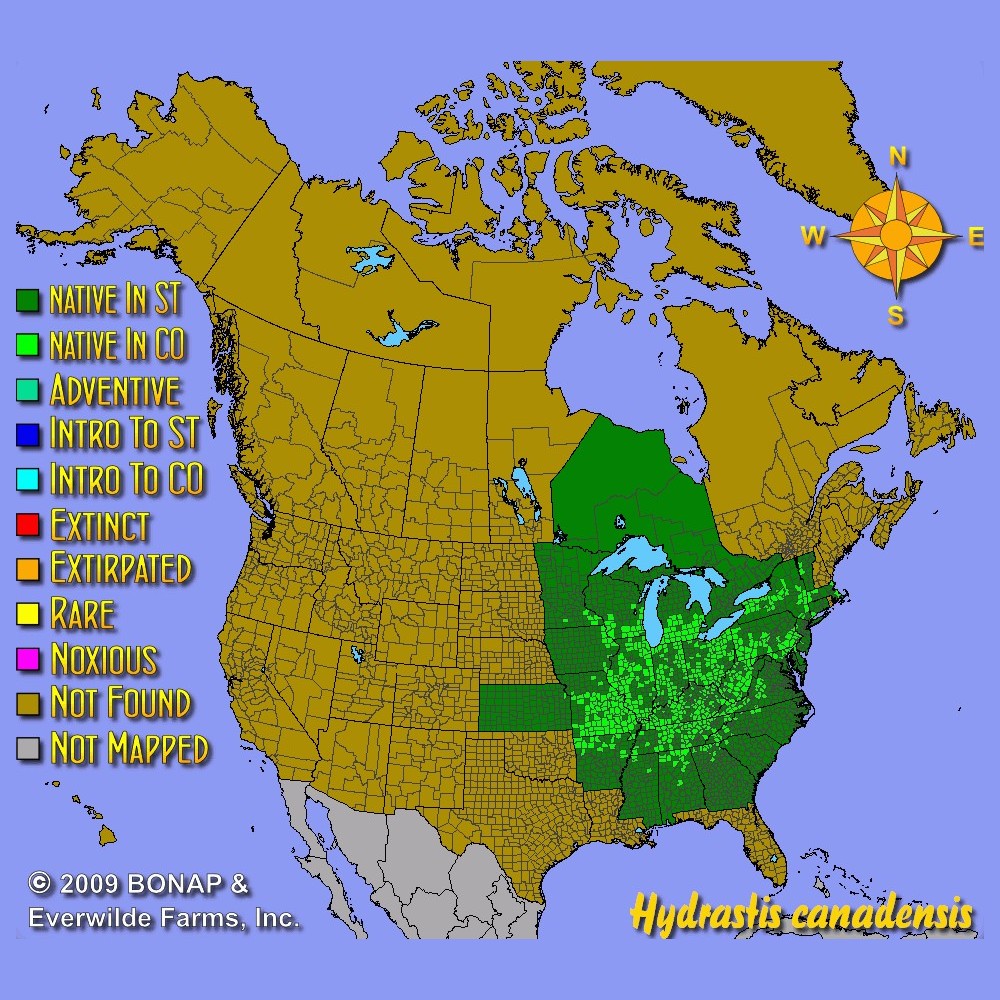Goldenseal Seeds
Hydrastis canadensis
- HOW TO GROW
- FAST FACTS
HOW TO GROW
Sowing: Soak the seeds for several hours, then mix them with moist sand; put the mixture into a sealed container or plastic bag to keep the moisture consistent, then store it at room temperature for 2 weeks before direct sowing 1/4" deep in late summer. Germination can be slow and irregular; some seeds may not sprout until their second spring. The soil must be kept evenly moist, since the seeds do not sprout when dry.
Growing: This plant grows best in moist but well-drained soil; do not overwater, since it does not tolerate muddy ground. Drought conditions, however, will cause the plant to go dormant prematurely. A layer of shredded leaves or straw will help conserve necessary moisture and control weeds, which is crucial in the first several seasons of development. The plants will slowly spread by self-seeding and rhizomes, though they will not become weedy.
Harvesting: Because of this plant's rarity, it should never be harvested in the wild. When grown from seed, the plants will be mature enough for a harvest of the roots in 5-7 years. In the dormant season of fall, carefully dig the roots, keeping them as unbroken as possible. The small pieces of roots left behind often enable the plant to regrow. Rinse the roots gently to remove as much dirt as possible, then spread them out to dry on a screen in a very warm, well-ventilated area. When the roots have become light and dry enough to easily break in two, store them in a cool, dry place.
Seed Saving: Pick the mature red berries and mash them; mix the berries with a small amount of water, and stir it to separate the pulp from the seeds. Discard the pulp and the seeds that float, and save the good seeds that sink to the bottom of the container. Keep the seeds moist and cool until planting.
FAST FACTS
Common Names: Yellow Puccoon, Ground Raspberry, Turmeris Root
Latin Name: Hydrastis canadensis
Species Origin: US Native Wildflower
Type: Native Wildflowers
Life Cycle: Perennial
USDA Zones: 4, 5, 6, 7
US Regions: Midwest, Northeast, Southeast
Seeds per Ounce: 2,300
Stratification: Cold/Wet for 12 Weeks, then Warm/Wet for 12 Weeks - Repeat
Germination Ease: Stratify 24 Weeks
Sunlight: Part Sun, Shade
Height: 10 Inches
Color: White
Bloom Season: Blooms Late Spring
DESCRIPTION

HOW TO GROW
Sowing: Soak the seeds for several hours, then mix them with moist sand; put the mixture into a sealed container or plastic bag to keep the moisture consistent, then store it at room temperature for 2 weeks before direct sowing 1/4" deep in late summer. Germination can be slow and irregular; some seeds may not sprout until their second spring. The soil must be kept evenly moist, since the seeds do not sprout when dry.
Growing: This plant grows best in moist but well-drained soil; do not overwater, since it does not tolerate muddy ground. Drought conditions, however, will cause the plant to go dormant prematurely. A layer of shredded leaves or straw will help conserve necessary moisture and control weeds, which is crucial in the first several seasons of development. The plants will slowly spread by self-seeding and rhizomes, though they will not become weedy.
Harvesting: Because of this plant's rarity, it should never be harvested in the wild. When grown from seed, the plants will be mature enough for a harvest of the roots in 5-7 years. In the dormant season of fall, carefully dig the roots, keeping them as unbroken as possible. The small pieces of roots left behind often enable the plant to regrow. Rinse the roots gently to remove as much dirt as possible, then spread them out to dry on a screen in a very warm, well-ventilated area. When the roots have become light and dry enough to easily break in two, store them in a cool, dry place.
Seed Saving: Pick the mature red berries and mash them; mix the berries with a small amount of water, and stir it to separate the pulp from the seeds. Discard the pulp and the seeds that float, and save the good seeds that sink to the bottom of the container. Keep the seeds moist and cool until planting.
FAST FACTS
Common Names: Yellow Puccoon, Ground Raspberry, Turmeris Root
Latin Name: Hydrastis canadensis
Species Origin: US Native Wildflower
Type: Native Wildflowers
Life Cycle: Perennial
USDA Zones: 4, 5, 6, 7
US Regions: Midwest, Northeast, Southeast
Seeds per Ounce: 2,300
Stratification: Cold/Wet for 12 Weeks, then Warm/Wet for 12 Weeks - Repeat
Germination Ease: Stratify 24 Weeks
Sunlight: Part Sun, Shade
Height: 10 Inches
Color: White
Bloom Season: Blooms Late Spring






